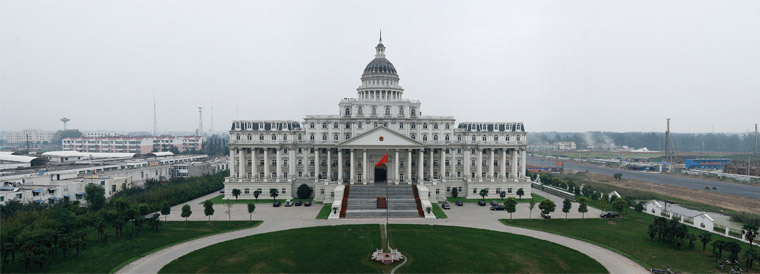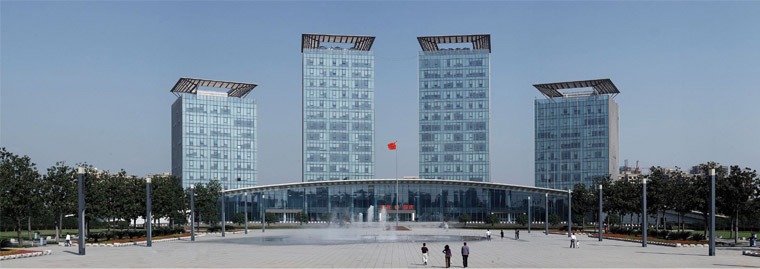BUILDINGS FOR CHINA: AESTHETICS AND GOVERNMENT ARCHITECTURE
| March 8, 2011 | Post In LEAP 7

In October 2009, Shenzhen-based photographer Bai Xiaoci began an expedition. He sought out public buildings built in major construction projects led by local governments—“government edifices”—around China and shot large-scale frontal portraits of them. He visited more than half of China’s provinces, traveling north to Hohhot, south to Shenzhen, east to Shanghai, and west to Chengdu, assembling a representative collection of the various styles of city and county-level government edifices. These photographs provide a rich visual documentation of the technical and aesthetic characteristics of Chinese government edifices and the basic political ecology of contemporary China.
Building Buildings, Revitalizing Cities
The objects of my photography are large government buildings located all around China. These buildings have sprouted up all over the place, to the point that I do not need to choose targets beforehand. Wherever I go, there is always a towering, magnificent building waiting for me.
This building boom is inseparable from “land financing,” the trend of local governments using the sale of land rights to prop up government revenues. To put it simply, these governments establish land markets by taking the initiative with their own projects and then slicing up neighboring land for development in order to earn extrabudgetary revenue. Here’s the background: the tax system reform in 1994 separated taxation into local and national taxes. The central government claimed the national taxes, which are the lion’s share; local governments’ revenues steeply declined, but their duties and responsibilities did not. Thus, local governments needed new sources of revenue. “Land financing” became the best method to fill gaps and generate income.
Local government officials of all levels are fond of luxurious government buildings. Because these buildings are the hens that lay golden eggs for government land rights, everyxone can find a reason to build one. Developers often lure high-end stores to new shopping centers with ultra-low rent deals in order to increase property values, and this sort of “brand effect” also applies to land markets, in which the government buildings are the high-end stores. The common practice is to bring in renowned urban planners and famous architects. Upon completion, the glorious building provides the people with a vision of the future and inspires confidence in the government’s efforts to transform an urban area. Thus, land prices go up.
The Inspiration: Louis XIV
These methods can be traced back to the seventeenth century, when, due to poor sanitation infrastructure, citizens would throw sewage in the streets of the dilapidated city of Paris. Some dissatisfied Parisians also threw stones at the imperial palace, leading King Louis XIV to relocate to Versailles, where his father, Louis VIII, had built a small chateau for hunting trips. Louis XIV requisitioned 6.7 square kilometers of land to build a new palace. Though the village of Versailles was scarcely populated and infrequently trafficked, he built three radial boulevards in order to attract new residents. Before long, the new city of Versailles was not only home to Europe’s largest, most magnificent palace, but also the center of art, culture, and aristocratic life for all of Europe.
Louis XIV’s exercise in city building demonstrated the tremendous benefits of government-led construction projects. From a pragmatic perspective, building government edifices is in fact a commercial strategy for urban activity. These buildings are showcases that serve the function of stimulating land markets by attracting buyers and raising prices.

From Political Principles to Architectural Aesthetics
So-called “political principles” are composed of a complete set of all-inclusive traditions and theories: spiritual leadership, theoretical texts, organizational life, rites and protocols—and of course, expensive buildings. Judging from government edifices, different political systems have different architectural aesthetic tendencies. Post-Industrial Revolution capitalists preferred a modernism devoid of religious and monarchic authority; Hitler’s Third Reich featured neoclassical pillars; Stalin’s socialism advocated a “national in form, socialist in content” aesthetic. In the contemporary era of globalized capitalism, an internationalism that further flattens out geographical differences has risen to the fore.
As material manifestations of Chinese political principles, China’s city- and county-level government buildings have also developed their own architectural aesthetics. State-owned design institutes are primarily responsible for the design of these structures. The skill level of these designers and the aesthetic preferences of local government policymakers have rendered these buildings of the late twentieth and early twenty-first century to appear as pastiches of bygone fashions and contemporary trends. The various government edifices I have photographed all employ some neoclassical elements: horizontal symmetry, decorative pillars, and lots of marble and granite. In the coastal provinces with relatively developed economies, some buildings feature glass curtain walls, but many others employ ethnic-style glazed tile roofs, emphasizing the political correctness of the nation-state.
With designs that emphasize order, these government edifices are always symmetrical in arrangement and cavernous in volume, providing a solemn sense of protocol to denizens and visitors. An individual wishing to enter a government edifice must first traverse a massive plaza, then ascend a massive set of stairs. From a bird’s eye view, the individual resembles an ant crawling in solitude across a taupe granite dish.
The Psychology of the Visitor
These painstakingly crafted architectural spaces, coupled with the political system, create a psychological experience for visitors. Take, for example, the experience of one visitor to a Baoji municipal government building, as described on the website “Baoji Island”: “That day, I took a bus to the south plaza of the government building. As I looked around, I saw that the grand ambience and layout would lead any first-time visitor to stop and take it all in. I climbed the tall staircase, and as soon as I entered the doors to the lobby, someone said, ‘What are you doing? Get over here and sign in.’ To the left was a registration desk where everyone had to sign in. Understanding that this was the usual practice, I went over and carefully wrote down all the required information. ‘What are those documents? You want to file a complaint, is that it?’ Once he saw that it was just a project report, he granted me admission.”
After finally entering the building, the visitor discovered that he had entered a sort of surreal dreamscape: dozens of identical, unlabeled doors. His sense of disorientation mirrors the universal experience of ordinary individuals upon entering these edifices.

The Ego of the Policymaker
For common people, government edifices signify the dispersion of the self; for policymakers, they signify the inflation of the self. In the ecology of the base-layer of Chinese politics, “building one’s own little world” is the common psychological aspiration of local officials. The construction of government edifices is a physical act to satisfy egos and manifest ideals of governance. The news media has thoroughly documented the case of the Zhang Zhi’an, the former Party secretary of the Yingquan district of the city of Fuyang in Anhui province. Zhang directed the construction of a Yingquan government building similar in appearance to the White House, a project that earned him the nickname of “White House secretary” (in fact, it more resembles the U.S. Capitol). Zhang was full of enthusiasm for design and construction, and after studying architecture for three years in Hefei, he was something of an amateur architect.
Previously, as the Party secretary of Xiaozhangzhuang village, Zhang had designed several European-style rustic villas. Each of the them is unique, and according to one visitor, they offer the opportunity to “step into a Hans Christian Andersen fairytale.” In 2001, after being promoted to Yingquan district Party secretary, Zhang began work on his long-planned “five major projects,” including the “White House.” There are several Chinese buildings that emulate the U.S. Capitol, but Fuyang’s is the most famous because Zhang Zhi’an diligently participated in the design himself, insisting on a strict reproduction of the original, down to the use of materials. The superlative effect of the completed edifice, from the Roman-style dome to the pillared facade, cannot be denied.
Symbolism and Function
The government edifices I photograph, from a construction perspective, are far from perfect. Despite the massive investments, their stiff designs do not prioritize the convenience and comfort of their users; the extravagant furnishings, lacking functionality, seem barren once everyone goes homes after work. These buildings have prime locations, but their practically negligible land costs transgress the rules of real estate economics. Representing more than mere physical spaces, these are architectural symbols of contemporary Chinese society, bearing the weight of political and economic functions, as well as ideological significance. These buildings have proliferated around the country, providing formidable visual spectacles for our present and our future.

